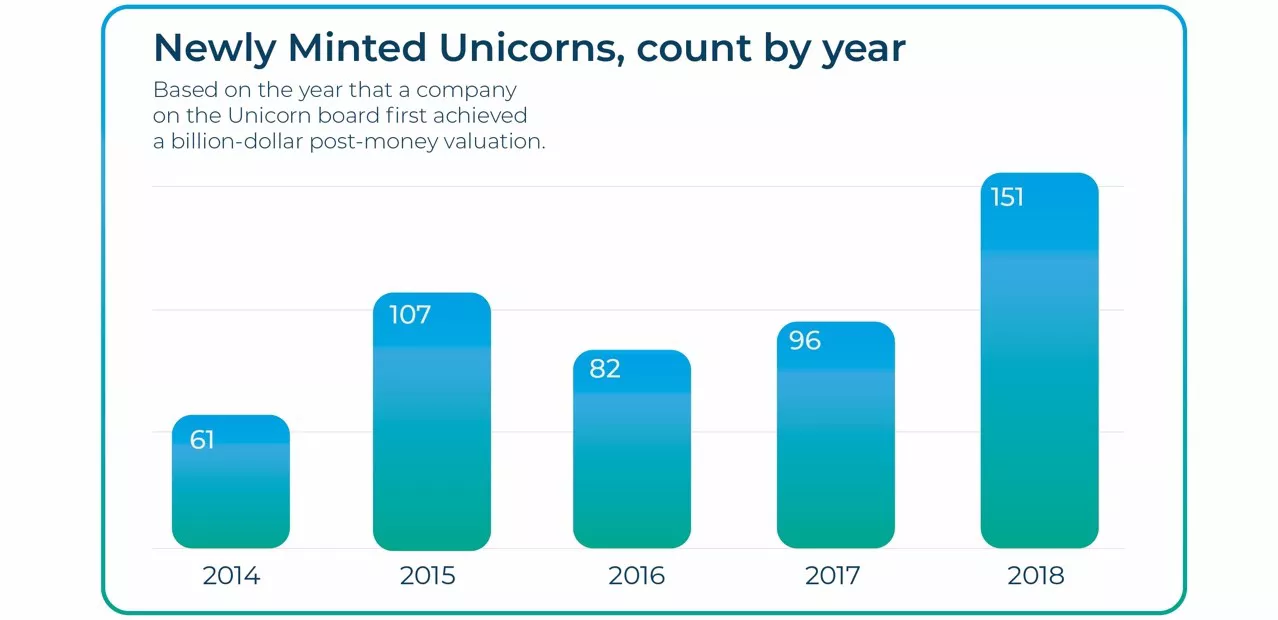Much has been said about the proliferation of tech unicorns, their superior ability to attract capital and, more recently, the giant wave of unicorn initial public offerings (IPOs). But behind this lies a story that's of crucial significance to established businesses: tech professionals, who would otherwise be drawn to innovation projects in traditional firms, are flocking to the darlings of Silicon Valley instead.
Follow the money: investment is flooding to tech unicorns
The race to IPO by the latest cohort of tech "unicorns" (startups privately valued over USD 1 billion), and their series of missteps along the way, have been covered full-bore by the media, and compulsively followed by the business establishment. But it's more than just large corporates warily eyeing these developments. Employees are noticing too.
Lyft set the stage. On March 28, the ride-hailing app went public and then tanked below its offer price on the second day of trading. More recently, Uber floated at $69 billion, down from its private market valuation of $120 billion nine months ago, distinguishing it as the debut that "lost more in dollar terms than any other American initial public offering since 1975".[1]
Despite these disappointing valuations, as many as 100 unicorns are waiting in the wings to list this year.[2] And it hasn't stopped UBS from declaring that "IPOs are likely to be prominent events in financial markets this year".[3] That these unicorns are transitioning or attempting to transition from private to public markets signals, to one and all, that they're entering the big league.
Five years ago, the fate of digital unicorns was not that significant: there were about 40 unicorns globally. Today, there are 452, estimated to be worth $1.6 trillion[4], with 2018 outstripping all previous years as 151 new unicorns joined the ranks (compared to 96 in 2017).

Source: Adapted from TechCrunch:
Five years ago, the US economy had its strongest growth rate since the recession. Today, the global economic outlook is less sanguine. Some have wondered if the gloomier forecast may be partly fueling the IPO surge, as unicorns scramble to launch at the top of the market. Others have mused about the market's chilled response to their launch. Ultimately, the IPO-unicorn debate turns on whether it's a momentary headwind, or a major pivot in the complex innovation-financing ecosystem that's emerged since 2014.[5]
As the debate roars on, it's continuing to foreground the VC-unicorn ecosystem phenomenon. This ecosystem centers around the unicorns winner-takes-all "Blitzscaling"[6] model, which is first and foremost a drive for hypergrowth.
The Blitzscaling model has reconstructed entrepreneurial finance systems, particularly in the US. And it has powered the staggering growth of digital native firms to disrupt incumbents in a wide variety of business sectors. What's more, their trailblazing path is impacting the talent pool as well.
Follow the talent: tech professionals are flocking to the tech giants
Just as private capital has been caught in the gravitational pull of the unicorns, so too have the best and brightest tech recruits leaving incumbent firms with the leftovers. In LinkedIn's Top Companies report, which parses the billions of actions of LinkedIn members to rank the most sought-after companies to work for, the leading tech companies come out ahead.[7]
And Silicon Valley's unicorn factory (and elsewhere) shows no signs of slowing. Says Bidyut Dumra, Head of Innovation, DBS Bank,
"Last year we had about 12,000 new [fintech start-ups] enter the market space, and they came in with private equity of around USD 31 billion. Even if 1 percent survives, that's 120 new [competitors] that you have to contend with. They are literally attacking any and every area and space where we have a service proposition. The key tipping point was when the large tech companies decided to jump into the space as well."[8]
For traditional business, not only are these companies mercilessly hitting them on certain customer segments, they are also depleting the talent pool from which they would normally recruit.
Some object to the brain drain thesis, claiming there's no shortage of talent at their firms. Where there is a need for specialist tech skills, it's just a matter of training their own people, so the logic goes. Having survived many a sling and arrow, these traditional corporates have those training programs baked into their modus operandi.
But today, arguably, the hallmark of a successful innovation project is the breakneck speed with which it goes to market. There's simply no time to train personnel at all.
Amid the battle to attract elite techies, traditional firms are contending with retention issues as well. When your top technologists walk out the door, lured by the salaries, prestige and excitement of working on bleeding edge projects for a tech giant, you stand to lose your IP immediately.
Consequences of the talent migration for legacy firms innovation projects
As with the tech firms, mainstream firms face the same mad dash to complete their projects quickly, implement them cleanly, and win over the market and even more so with a potential economic downturn on the horizon. This pressure is not helped by the fact that the financial engineering sweeping the private markets has caused distortions not just in financial flows, but in the talent flows as well.
Tech innovation is devilishly hard. It requires tenacity and is subject to the most intractable constraints. Financing the innovation project is a barrier, the cyclical nature of the economy is another, and the sourcing and retention of teams is another one. Oftentimes, constraints such as these kill an innovation, rather than the lack of tech.
References:
[1] https://www.nytimes.com/2019/05/15/technology/uber-ipo-price.html
[2] https://www.ubs.com/microsites/wma/insights/en/investing/2019/year-of-the-unicorn.html
[3] https://www.ubs.com/microsites/wma/insights/en/investing/2019/year-of-the-unicorn.html
[4] https://techcrunch.com/2019/05/29/the-crunchbase-unicorn-leaderboard-is-back-now-with-a-record-herd-of-452-unicorns/
[5] https://kenney.faculty.ucdavis.edu/wp-content/uploads/sites/332/2018/11/Unicorns-Chesire-cats-and-new-dilemmas-of-entrepreneurial-finance-1.pdf
[6] R. Hoffman and C. Yeh, 'Blitzscaling: The Lightning-Fast Path to Building Massively Valuable Companies', HarperCollins, 2018
[7] https://www.linkedin.com/pulse/top-companies-2019-where-us-wants-work-now-daniel-roth/?trk=lilblog_04-08-19_top-companies-skills_learning
[8] http://cisr.mit.edu/blog/documents/2019/03/08/mit_cisrwp436_dbs-futurereadyenterprise_siaweillxu.pdf/